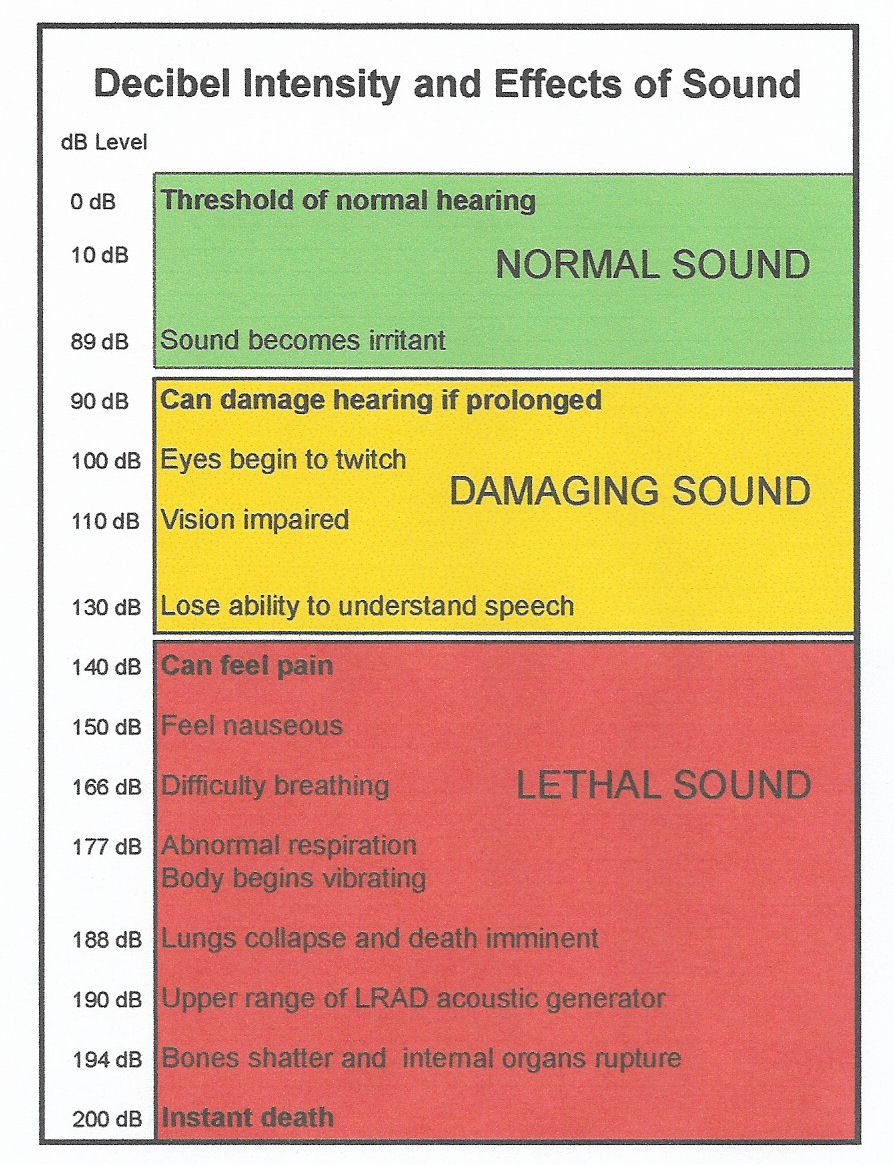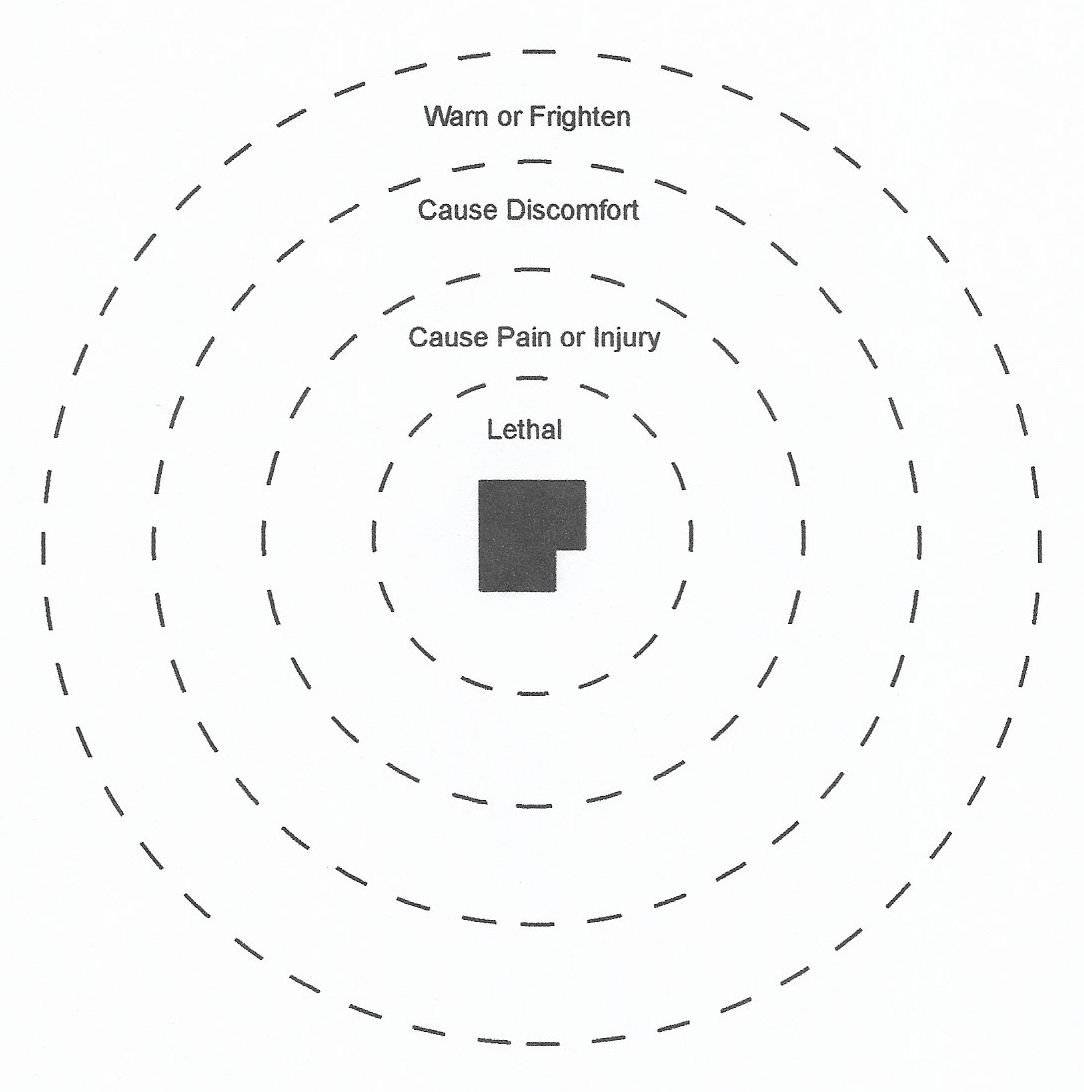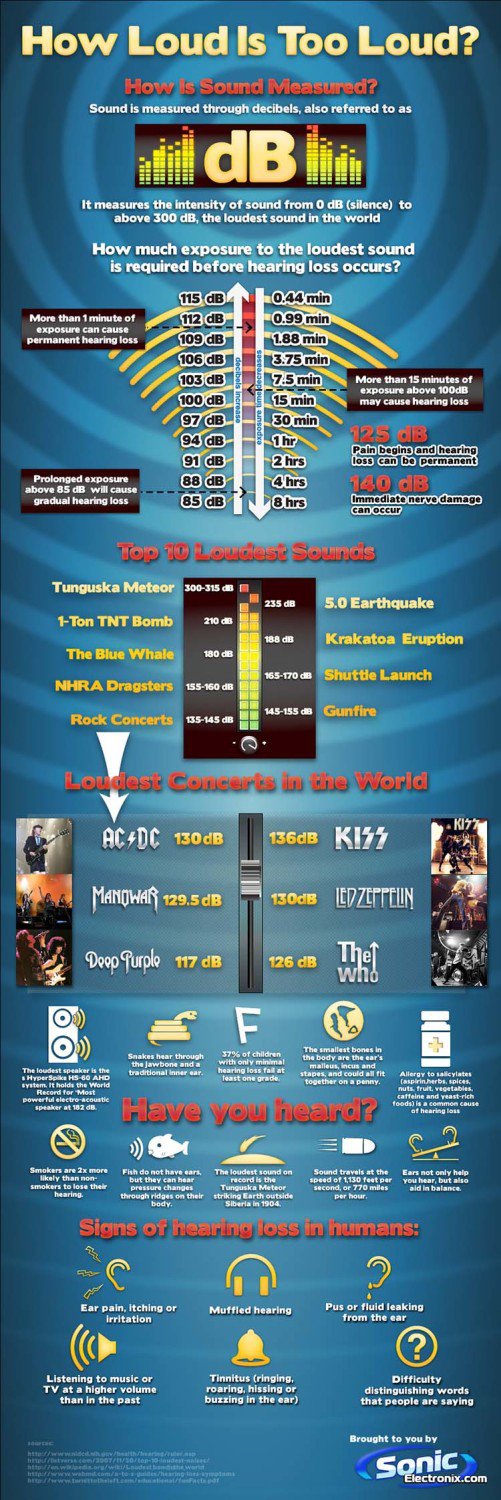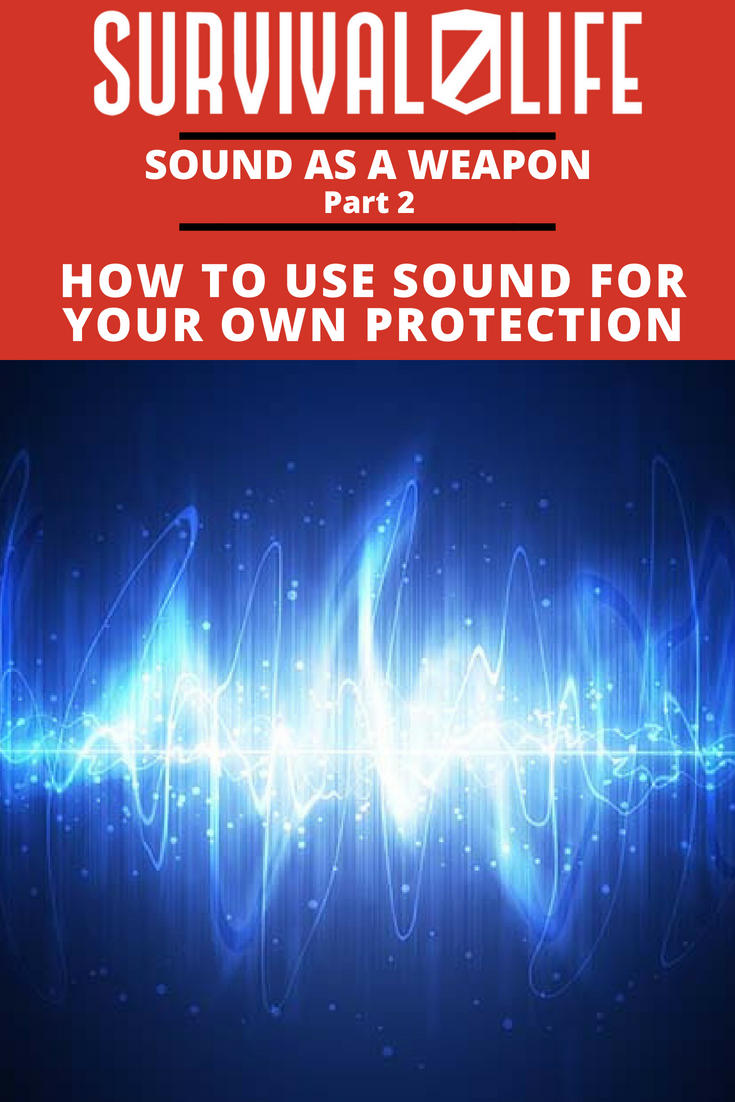Survival Skills
Sound as a Weapon pt 2: How to Use Sound for Your Own Protection

Sound is a powerful force that we can use to protect our family, our property, and ourselves. Danger is growing out there, and you’ll need all the resources you can gather to counter threats. This article will share resources and techniques for using sound to save your life in future SHTF scenarios.
Sound affects us all. Figure 1 summarizes the physical effects of sound on the human body.

Fig. 1 – The effects of sound pressure on the human body.
The effects of sound pressure on the human body.
When a threat approaches you have two options—fight or flight. Remain and face the threat, doing all you can to stop the approach, or run away. If you’re in the city and the threat is a hostile crowd that begins looting and attacking innocent people, you can try to avoid the crowd by turning away and walking at a perpendicular to the movement of the threat putting distance between yourself and the chaos behind you.
But if you’re at home, your options are reduced. You can grab your Bug-out bag and “get out of Dodge,” hoping to defend yourself and your family out on the road. Or you can choose to defend your home and your family by sheltering in place. In this case choose every weapon possible to keep evil from getting to you and your loved ones. Anything and everything around you becomes a possible weapon.
When danger is approaching, your best strategy is to stop the threat before it gets to your home. Estimate the approximate age of the crowd so you can select the appropriate sound deterrent. The key is to use overwhelming force to change the behavior of threats. There are four ways to use sound to do this:
- Warn or frighten.
- Cause discomfort.
- Cause pain.
- Cause physical damage or worse.
Imagine a scenario in which an invisible field surrounds your home or encampment (Figure 2). The field is comprised of a series of threat response zones in which anyone entering a field is exposed to increasingly harmful sound waves.

Fig. 2 – Threat response zones.
Zone 1 – Warn or Frighten
The furthest out is designated the “warn or frighten” zone. If you could send loud sound toward a group, you may stop them. A device that directs sound onto a target is a form of “directed energy weapon.” In Zone 1, loud sounds and sirens could be used to deter looters. For example, you could produce sound with an air blast horn, a loud truck horn, or an amplifier with speakers that can withstand very high intensity sound without blowing out the speaker paper. Multiple speakers mounted high above the crowd could put out unnerving sound. And you could mount speakers low inside your fence that create snarling dog sounds. Out at the perimeter, multiple senses could be targeted – e.g. sound and a strobe light. The idea is to turn threats away with loud, obnoxious noise and light that stops intended movement.
You can also produce sounds that frighten a hostile group. The sound of a mean, snarling dog on the other side of your fence can instill fear and cause people to pause and consider moving on to an easier prey. Fear is the intended reaction. Here are some options:
- Growling snarling dog
- Several dogs growling
- Large dog barking
- Scream of an angry fox
- Rattlesnake sound
- Snapping rat traps
- Buzz of a bee hive
- Racking a weapon
- Cocking a gun
- Shotgun being fired
https://www.youtube.com/watch?v=Wcevwtq60Tc
These sounds produce mental images that can immediately create fear and prompt action to avoid. The fear response is a powerful deterrent because our brains have evolved to be afraid of these sounds. And this reaction is universal. Hearing never turns off even if we shut our eyes. Just hearing certain sounds can be terrifying to an approaching crowd and convert hostile people into whimpering, scared little children.
If it’s dark, eerie unnatural sounds may frighten a crowd to back off and leave. Consider sounds like ghostly movement, doors creaking open, an ear-piercing scream, or a screeching monster. Here are two links to free sound sources:
http://www.szworld.net/scary-sounds/
http://soundbible.com/tags-scary.html.
Zone 2 – Discomfort

If the actions in the first zone don’t work and looters enter the “discomfort” zone, apply low frequency sound energy with the intent to make people ill, irritated, or very uncomfortable. Make it increasingly punishing for those who continue toward you. If the threat is from young, unruly gangs, use high frequency (20,000 Hz) sound to drive them away. If the threat is from older looters, use low frequency (under 20 Hz) sound to make them nauseous, and cause disorientation, anxiety, and fear.
As the frequency is increased to about 18 Hz their eyeballs begin to resonate and vision gets blurred. Looters could also feel nauseous, and have difficulty swallowing. Many will get frightened and lose concentration. Some will have panic attacks.
By focusing the sound through a megaphone-shaped device away from you and toward a hostile group, you can increase the sound pressure so it’s physically damaging. On the LRAD site is a video showing demonstrators attempting to approach a police line only to have the sound generated by the LRAD get so loud they held their ears and retreated. Their actions followed the inverse square rule—only by getting far away from the source could they tolerate the noise. None of them reached the police line.
Zone 3 – Pain or Injury
In this threat response zone sound energy is used to punish or damage a hostile threat. Physical pain becomes intense when sound pressure reaches 140 dB—fireworks, a gunshot, boom cars, and the 130-150 dB sounds of truck and train air horns.
By blasting out sound at these dB levels, you cause pain in the people approaching. Increase the dB and you can damage organs in the bodies of any human threat.

(Image via)
Low frequency sound (infrasonic or infrasound) at less than 20 Hz can be felt rather than heard. This sound can cause feelings of fear, anxiety, depression, nausea, gagging, painful swallowing, disorientation, and hallucination.
Above 80 dB, infrasound between 0.5 and 10 Hz can cause disorientation increasing heart rate, rapid respiration, and high blood pressure.
At 10 Hz, you can also cause pain and vomiting. The frequency determines what type of damage; sound intensity determines the extent of the damage.
From 100 to 140 dB, infrasound can hurt—the higher the amplitude, the greater the pain and the more damage. Infrasound (0-20Hz) and low frequency noise (20-500 Hz) can cause disease to go unchecked.
At 90 dB, damage to the body can occur—hearing could be the first to go. Increase the sound intensity to 100 dB and infrasound can hurt. People may begin vomiting.
At 130 dB, people will lose the ability to understand speech. At 140 dB pain becomes intense.
At 10 Hz and 143 dB gagging will occur along with pressure in the chest. Breathing can become irregular.
Between 30 Hz and 100 Hz, bowl spasms and stomach disorder can occur. The natural frequency of the kidney is about 320 Hz. For the bladder it’s 352 Hz and for the colon it’s 176 Hz. Generate these frequencies and increase the dB intensity to cause resonance with these organs and you may cause them to involuntarily urinate and defecate. Soiled clothes are embarrassing and discouraging in public.
At ultrasonic frequencies, people will feel the same infrasound effects but can also feel their bodies heating up and burning internally.
Zone 4 – Lethal Zone
If threatening people stubbornly move into close proximity to your home, and enter the lethal zone, increase the dB and apply whatever sound force is necessary to stop the threat.
CAUTION: Using lethal sound against violent people—even if they have no reservations in hurting or killing you—may make you liable in our politically correct world. It may be better to incapacitate the threat.
At 140 dB they’ll feel pain. Audio pressure higher than 140 dB can lead to painful death.
At 150 dB they’ll feel sick and their chest and abdomen will begin to vibrate. Just moving about can make them vomit.
At 160 dB severe internal damage occurs. At 166 dB these low-frequency pulses will impact their lungs and they’ll have trouble breathing. Sound waves can now be produced that are so powerful they can knock down walls and shake machines apart. This kind of pressure can tear up the inside of a human.
When the sound intensity reaches 177 dB, the body begins vibrating and they’ll experience abnormal respiration. If they’re standing on the ground, vibrations from the earth will pass through them causing their whole body to move up and down at 4-8 Hz and side to side at 1-2 Hz. Bone and joint damage will occur and they’ll suffer chronic exposure effects—if they survive.
At 188 dB, the lungs can collapse and death becomes imminent.
Sound energy at 194 dB—even at infrasonic frequencies—can shatter bones and shake internal organs apart. As sound pressure increases they’ll stop breathing and succumb to the sonic death wave. No looter can live facing 200 dB of sound energy. This is very serious stuff, but the objective is the same—survival.
In the next article I’ll discuss how you can protect yourself when using your own debilitating or deadly sound waves against others, and what to do when rioters use sound weapons against you and your family.

For more on self-defense, check out the articles below:
Simple But Effective Self Defense: Throat Strike
Self Defense Tactics: Close Quarters Defense
Best Martial Arts for Self Defense
-

 Do It Yourself7 months ago
Do It Yourself7 months agoParacord Projects | 36 Cool Paracord Ideas For Your Paracord Survival Projects
-

 Do It Yourself9 months ago
Do It Yourself9 months agoHow To Make Paracord Survival Bracelets | DIY Survival Prepping
-

 Do It Yourself9 months ago
Do It Yourself9 months ago21 Home Remedies For Toothache Pain Relief
-

 Do It Yourself10 months ago
Do It Yourself10 months agoSurvival DIY: How To Melt Aluminum Cans For Casting
-

 Exports8 months ago
Exports8 months agoAre Switchblades Legal? Knife Laws By State


Pingback: Sound As A Defense Weapon: How Sound Frequency Can Cause Pain - Survive!
Pingback: Sound as a Defense Weapon: How Sound Frequency Can Cause Pain